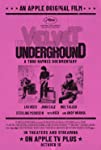Eye For Film >> Movies >> The Velvet Underground (2021) Film Review
The Velvet Underground
Reviewed by: Anne-Katrin Titze

Todd Haynes’ The Velvet Underground (a highlight in the Main Slate programme of the 59th New York Film Festival) captures the transformation and growth of Lou Reed, John Cale, Maureen Tucker, and Sterling Morrison, after the band was introduced by Barbara Rubin to Andy Warhol, who added Nico into the mix. Terrific on-camera interviews (shot by Ed Lachman, whose Songs For Drella is a Revival highlight) with Lou’s sister Merrill Reed Weiner, Jonathan Richman, Amy Taubin, John Waters, Jackson Browne, Mary Woronov, Gerard Malanga, La Monte Young, Doug Yule, Danny Fields, Sterling’s wife Martha Morrison, Tucker and Cale, and archival clips of performances capture the events and goings on in New York at that time.
Are you tired of the current flood of documentaries that throw together ugly animations, some discreetly confusing or not-so-discreetly annoying reenactments, talking-head experts who get to say very little that is meaningful, and a sheer endless repetition of the same archival clips and photographs to stretch out the viewing time and make it possible for you to cook a meal and read a book at the same time?
The Velvet Underground will restore your belief in documentaries! Todd Haynes in all his films, and often aided by longtime cinematographer Lachman (Dark Waters, Wonderstruck, Carol, I'm Not There, Far From Heaven), never gives an inch of aesthetic pleasure for substance, as we realize they can be the same. In this case especially, add the music to it and the split screen unfolds like a precocious flower, sometimes cut into the little boxes we all have become so cosily familiar with in these pandemic times.
An overfull experience of what was and is The Velvet Underground and its periphery is the result. “Music fathoms the sky…” - the quote by Baudelaire functions as epigraph and Andy Warhol’s Screen Tests, where the subject looks straight at us, lasso us in while moving footage from the Sixties flickers and winks and visually comments on what we are hearing, as if we were partly dreaming. A mood and Lou Reed’s voice likening going to the movies to a drug.
Reed’s sister talks about their father, the move to the suburbs, and later on delights Haynes with an impromptu dance performance to Lou’s song The Ostrich. John Cale paints a grim picture of his grandmother in Wales who didn’t want her daughter to marry an Englishman, even less a coal miner. We see eyes and birds and a school class. Cale’s mother, “she vanished” in “an isolation hospital.” He talks about his dreams of wanting to be a conductor. Very amusingly, Haynes shows us a train at that moment!
New York City; Jonas Mekas, to whom the film is dedicated, states about the Sixties that “we are not sub- or counter-culture, we are the culture,” 42nd Street and the “poetic aspect of cinema.” John Cale talks about John Cage and we see his performance on I’ve Got a Secret on national television, puzzling and delighting and educating mainstream audiences.
Meanwhile, Lou Reed at Syracuse University played fraternities and bars with his band. They had to change their name often, “because we were so bad.” The books to read were by Ginsberg and Rimbaud, Selby and Burroughs. Back in the city, 56 Ludlow Street was the address to live at in early 1964. “New places in sound that you can find a home,” La Monte Young says.
“The 60 cycle hum of the refrigerator was to us the drone of western civilization” says Cale. Amy Taubin discovered Andy through The Kiss and understood how for Warhol “it was all about extended time.” Her analysis is fascinating and in one of the film’s most interesting sequences, she speaks about how the Factory “was not a good place for women.” The exploitation of looks and all that goes with it are too often overlooked in romanticized depictions and I wanted to hear more from her first-hand account on that topic.
“Writing about things that hurt,” was Heroin. “Lou’s tales of shock therapy brought it all together,” says Cale: “How to be elegant and how to be brutal.”
On to a long sequence around Nico, who did not accept Andy’s suggestion to sing inside a plexiglass box. She sings about being our mirror. Jackson Browne comments that “the spectacle of her beauty was completely besides the point for her.” Reed puts it this way: “Andy produced our first record in the sense that he was there breathing in the studio.”
Jonathan Richman does not hide his fascination with the Velvet Underground then and now. “These people would understand me,” he concluded upon first hearing them. We see a little kid in a marinière shirt roaming around the instruments, there is Ginsberg introducing Peter Orlovsky, Mekas, and Ed Sanders from The Fugs, multi-media takes over the Dom in the East Village, where everyone came to dance, Nureyev included, while Barbara Rubin projected polka dots on the stage. It all melts together, an alienating trip to the West Coast, distain for hippies, and closer and closer to the bad breakup of the band. Sterling Morrison was sent to inform Cale, very inelegantly, of Reed’s ultimatum and the decision made.
“I’ve come to hate my body and what it requires in this world” are the lyrics to a song given by Lou Reed to the new member of the band, Doug Yule, who replaced John Cale. We get to hear the irresistible “If you close the door” sung by drummer Maureen Tucker, go to Max’s Kansas City and see images of nature flickering by very very fast. “It had entropied” - is that the band or the world? At this point, Haynes has us in the palm of his hands and I don’t know may be the most accurate of all answers.
Reviewed on: 28 Sep 2021
















